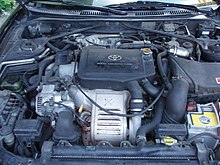Toyota 3S-GTE
The 3S-GTE is an in-line four-cylinder turbo- charged gasoline engine from Toyota with a displacement of 1984 cm³ (2.0 l). The engine was mainly installed in the Celica and the MR2 , outside Europe also in the Caldina . The cylinders are numbered from 1 to 4, starting with the toothed belt. The firing order is 1-3-4-2. The engine consists of a cast iron block and an aluminum cylinder head , which was developed in cooperation with Yamaha . The turbochargers are manufactured by Hitachi .
Expansion stages
Generation 1
The 3S-GTE engine saw the light of day in 1987 as the heart of the Celica 4 × 4 Turbo (outside Europe also called Celica GT-Four ). The first generation used the CT26 turbocharger and mobilized 185 hp at an engine speed of 6000 rpm. The maximum torque was 250 Nm at 3600 rpm. The turbocharger generated a maximum of 0.5 bar boost pressure from approx. 3000 rpm. The compressed air was cooled by a water / air charge air cooler .
Generation 2
With the model change at Celica in 1990, the second generation of the 3S-GTE followed. In addition to minor changes to the engine itself - such as increasing the compression ratio from 8.5: 1 to 8.8: 1 - an air / air charge air cooler has now been used. The CT26 was again used as a turbo, which has been further developed in terms of reliability. The new engine now made 204 hp / 275 Nm in the Celica 4 × 4 Turbo. In 1993, on the occasion of the WRC driver title in 1990 and 1992, Carlos Sainz presented a special series of the Celica 4 × 4 Turbo, the Celica Carlos Sainz Limited Edition, limited to 5,000 units worldwide for the purpose of homologation . In addition to the badge with the edition number and the externally different body kit , the car had a slightly modified 3S-GTE of the second generation under the hood, which, like the first generation, had a water / air intercooler and generated 208 instead of 204 hp.
Generation 3
In 1994 a new model came out again. Inspired by Toyota's success in the WRC , Toyota's got the 3S-GTE together with permanent all-wheel drive, this time under the official name GT-Four . The new engine now developed 242 hp and 305 Nm at around 0.9 bar boost pressure. The most obvious change is the conversion of the turbocharger from the CT26 to the CT20b (this name was never officially used by Toyota, but this model name is common among insiders). In the Japanese Caldina GT-Four, a slightly modified version of the 3S-GTE was used from 1997, again with an air / air intercooler and 265 hp. The original Gen3 engine also made 265 hp on the home market, as 100 octane gasoline is very common in Japan and the control unit of Japanese engines was set to this type of gasoline. Hence the increased performance compared to the export models, which were set to 95 octane gasoline. This expansion stage is often incorrectly referred to as Generation 4, but experts on the 3S-GTE classify this engine as Gen3 +. As of 1998, the Celica GT-Four was no longer sold, so no more cars with the 3S-GTE were sold in Europe.
Generation 4
In 2002 the third generation of the Caldina was presented, which again featured a top-of-the-range turbo-charged engine. The fourth generation had a new turbocharger and, like the previous generation, made 265 hp. Changes to the engine only served to optimize consumption and environmental friendliness.
The engine in other models
Outside the Celica, the 3S-GTE was still installed in the Caldina GT-Four (generation 3+ and 4), and from 1990 to 1999 in the Toyota MR2 Turbo. The second generation with 204 hp was used here until 1994; the last models in this series worked with the third generation. MR2 turbos are very rare and therefore very popular, the so-called "Late Spec" were produced almost exclusively for the Japanese market.
Apart from the series, the 3S-GTE is popular in the Toyota scene because of its (relatively) compact design and high stability, even with increased power for engine conversions. Companies such as B. fensport, but also private individuals have already installed the engine in everyday cars such as the Corolla or in the current edition of the Celica (which does not have a supercharged engine as standard).
Motorsport
In the all-wheel drive era of rallying, the 3S-GTE formed the backbone of Toyota's efforts in the WRC. The racing engines had an output of around 300 hp and 500 Nm. The most important successes were:
- WRC driver title 1990 ( C. Sainz / L. Moya, Celica ST165)
- WRC driver title 1992 (C. Sainz / L. Moya, Celica ST185)
- WRC driver title 1993 (J. Kankkunen / N. Grist, Celica ST185)
- WRC works title 1993
- WRC driver title 1994 (D. Auriol / B. Occelli, Celica ST185)
- WRC works title 1994
- WRC works title 1999
After Toyota's withdrawal from rallying in favor of Formula 1 , Toyota vehicles are only driven in rallies by private teams.
